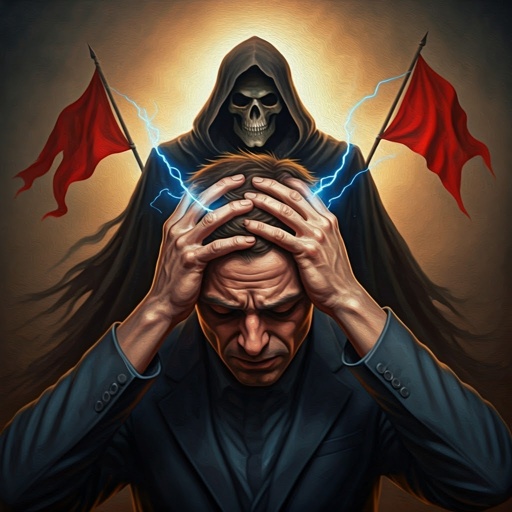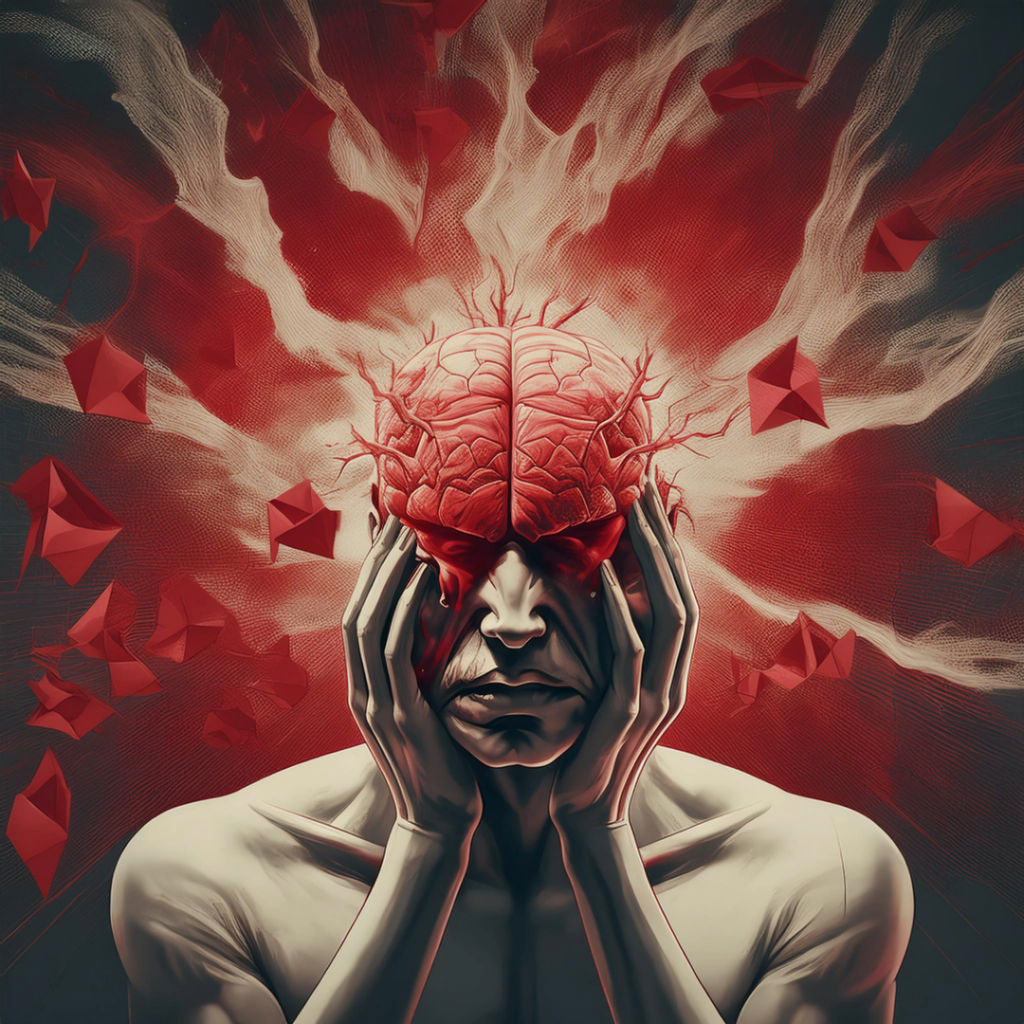Headaches are a common ailment that most people experience at some point in their lives. They can be very scary, caused by anything from a benign primary headache disorder such as migraine to a more emergent secondary headache such as brain tumor, stroke, or meningitis. Knowing when to be concerned about a headache is crucial for ensuring your health and well-being. While many headaches are benign and manageable, there are headache red flags that could indicate a life-threatening condition warranting emergent evaluation. Understanding these headache warning signs can help you make informed decisions about when to seek urgent medical attention for a headache.
Understanding Common vs. Concerning Headaches
Different types of headaches are classified into two primary categories: primary and secondary headaches. Primary headaches, which include tension headaches (most common type of headache), cluster headaches, and migraine headaches, are not caused by another medical condition. They often arise from factors such as stress, dehydration, hormonal fluctuations, or environmental triggers. Although they can be quite painful and disruptive, primary headaches generally do not indicate a serious health problem. This free headache symptom checker analyzes for possible common primary headache disorders that you can discuss with your doctor.
On the other hand, secondary headaches are a symptom of an underlying medical issue. These could range from more benign conditions, such as sinus infections or high blood pressure, to more severe causes like brain tumors, meningitis, brain aneurysms, or other problems with the blood vessels in the brain. The distinction between primary and secondary headaches is crucial because secondary headaches often come with additional neurological symptoms or a sudden, severe onset that necessitates urgent medical evaluation.
When evaluating your headaches and head pain, it’s essential to consider the context and accompanying symptoms. For instance, if your headache is accompanied by a fever, stiff neck, immediate maximum pain at onset (thunderclap headache), a “first or worst” headache, neurological symptoms, or occurs after a head injury, it could be a sign of a more serious condition and all would warrant emergent evaluation in the nearest emergency department.
Recognizing these patterns can help you make informed decisions about seeking medical attention and ensure that any potentially life-threatening issues are addressed promptly. For example, 25-50% of patients with a subarachnoid hemorrhage (brain bleed due to an aneurysm rupture) die before even reaching the hospital! So it is crucial to not ignore certain symptoms, and know what to watch for. Understanding these distinctions will better equip you to differentiate between common, benign headaches and those that may signal a more serious health concern.
Both primary headaches and secondary headaches can present with frequent headaches or occasional headaches. Both can include head pain on both sides of the head, one side of the head, or in any pattern. Any headache regardless of how mild it may be needs to be discussed and evaluated with your doctor before assuming it is a benign primary headache disorder, because some bad secondary causes of headache can also appear as milder primary headaches.
Recognizing 5 Headache Red Flags That Require Immediate Medical Attention
Headaches associated with certain symptoms require immediate medical evaluation. Here are some critical headache warning signs that demand immediate medical attention:
1. **Sudden Onset**
Headaches that start as sudden severe intense pain (thunderclap headaches), like “the worst headache of your life,” may indicate a subarachnoid hemorrhage (brain bleed due to an aneurysm rupture) and warrants immediate medical help. These are typically 10 out of 10 level intense headache pain immediately at the onset, and this is the classic “red flag” symptom. As mentioned above, 25-50% of patients with a subarachnoid hemorrhage die before even reaching the hospital, so you do not want to ignore it.
2. **Neurological Symptoms**
Headaches accompanied by symptoms such as confusion, difficulty speaking, numbness or weakness on one side of the body, vertigo, imbalance, and vision changes may suggest serious issues like a stroke.
3. **Accompanied by Fever or Stiff Neck**
A headache that comes with fever, neck stiffness, confusion, or sensitivity to light might be a sign of meningitis, a severe infection.
4. **Headaches After Injury**
Any headache following a head injury, even if it seems minor, could indicate a concussion or other severe conditions including bleeding into the brain which can happen slowly or quickly, and both can be fatal.
5. **Persistent or Severe Headaches**
When headaches persist longer than usual, are significantly more severe, or have a much different pattern than your typical headaches, it’s essential to have them evaluated.
Recognizing these red flags can help you understand when to seek immediate medical attention for a headache.
Additional Secondary Headache Red Flags Needing Evaluation, and Their Potential Causes
Secondary headaches often signal underlying medical conditions that need attention. Unlike primary headaches, secondary headaches are symptoms of another medical cause rather than standalone issues.
Here are some potential causes of secondary headaches which warrant an evaluation with your doctor or a trip to the emergency room if you can not see your doctor right away. A good way to remember them is the SNOOP4 mnemonic, which highlights associated symptoms with a headache which makes it more concerning:
**Systemic symptoms and signs (fevers, weight loss) could suggest infections such as meningitis or other infections such as sinus infection, cancer, or vasculitis (inflammation of the brain arteries). A history of HIV, cancer, autoimmune disease, or the use of immunosuppressive medications make this presentation even more worrisome and the evaluation more critical.
**Neurologic symptoms or signs such as numbness, weakness, vision disturbances such as vision loss or double vision, confusion, problems speaking or understanding, vertigo, imbalance, falls, or any other neurologic type symptoms could suggest stroke or brain tumor.
**Onset sudden could suggest brain bleed, aneurysm rupture, arterial dissection, or a CSF leak.
**Older age at onset (more than 50 years old) could suggest brain tumor, or temporal arteritis (giant cell arteritis) which is an inflammation of the arteries in the head and can cause blindness. A new headache should always be discussed with your doctor, but if it begins after age 50, this should be done as soon as possible.
**Pattern change/Progression could suggest brain tumor. If you have a history of headaches but notice a sudden change in their frequency, intensity, or duration—such as daily headaches after having them infrequently—it’s time to consult a doctor. Persistent headaches should always be evaluated.
**Precipitated by Valsalva maneuver (such as when you are bearing down while having a bowel movement or similar activities when holding in a deep breath against a closed mouth and nose to increase the intrathoraic pressure) could suggest a tumor in the back part (posterior fossa) of the brain.
**Positional aggravation triggered by either standing up or lying down could suggest low cerebrospinal spinal fluid pressure (CSF leak), or high pressure from hydrocephalus or Idiopathic Intracranial Hypertension (IIH), respectively.
**Papilledema (swelling of the optic nerves in the back of the eyeball) is something that might be noted during your routine eye exam with your ophthalmologist. This could suggest high CSF pressure from IIH or brain tumor.
Understanding these potential causes can help you and your healthcare provider identify the root of your headaches and determine the most appropriate treatment plan.
When to Seek Medical Attention for Persistent or Severe Headaches
If you experience persistent or severe headaches that do not respond to standard treatments, it is imperative to consult a healthcare professional. A “first or worst” headache always warrants an urgent evaluation .Seek medical attention if your headaches are accompanied by symptoms such as vision disturbances, vertigo, cognitive changes, confusion, fever, stiff neck, or any neurological symptoms such as trouble speaking, numbness, or weakness. A history of chronic conditions like cancer, HIV, or other immune disorders can increase the risk of secondary headaches, making professional evaluation even more critical.
Additionally, any headache following a significant life event, such as pregnancy or menopause, may require further investigation. The abrupt onset of severe headaches, especially those deviating from your usual headache patterns, should prompt immediate medical consultation. Changes in headache frequency, intensity, or duration—such as daily headaches replacing occasional ones—can also signal the need for a thorough medical review.
It is particularly urgent to see a doctor if your headache occurs after a head injury, no matter how minor it seems. Such headaches can be indicative of serious conditions like concussions or forms of bleeding into the brain. Finally, if you find yourself relying increasingly on over-the-counter medications without relief, it’s time to seek professional advice to prevent the potential for medication-overuse headaches (rebound headaches). Always err on the side of caution and prioritize your health by consulting with a healthcare provider when in doubt. The bottom line is that any type of headache should be discussed with your doctor.
Diagnostic Approaches for Evaluating Serious Headaches
When seeking medical attention for serious headaches, your healthcare provider will perform a detailed evaluation to identify the cause. This typically starts with a thorough medical history, focusing on your headache patterns, related symptoms, and any significant personal or family medical history. Next, a physical examination, as well as a neurological examination, will be conducted to assess for abnormal findings.
Imaging tests like an MRI or CT scan may be used to detect structural issues such as brain tumors or bleeding. Blood tests could also be necessary to identify infections or other systemic conditions contributing to your headaches. Additionally, a lumbar puncture (spinal tap) might be performed to check for signs of conditions like meningitis or subarachnoid hemorrhage if there is enough concern for this possibility.
These diagnostic steps are crucial for pinpointing any serious underlying conditions and guiding the treatment plan.
Conclusion
Headaches can be a scary symptom, especially if it is a new symptom that you’ve not previously dealt with. The causes are vast. Many are benign primary headache disorders such as migraine or tension-type headache. However, others are caused by a secondary headache in which the headache is a symptoms of a more concerning underlying medical condition such as brain tumor, stroke, or meningitis. Although every headache should be discussed and evaluated by your doctor, especially if it is a new headache, knowing the red flags of more concerning secondary causes of headache should prompt a more urgent evaluation. If you are not sure, it’s always better to stay on the safe side and not try to mask it with over the counter pain relievers, but rather discuss your headache with your doctor.
IF YOU HAVE HEADACHE, MIGRAINE, OR FACIAL PAIN AND ARE LOOKING FOR ANSWERS ON ANYTHING RELATED TO IT, A HEADACHE SPECIALIST IS HERE TO HELP, FOR FREE!
FIRST, LET’S DECIDE WHERE TO START:
IF YOU HAVE AN EXISTING HEADACHE, MIGRAINE, OR FACIAL PAIN DIAGNOSIS AND ARE LOOKING FOR THE LATEST INFORMATION, HOT TOPICS, AND TREATMENT TIPS, VISIT OUR FREE BLOG OF HOT TOPICS AND HEADACHE TIPS HERE. THIS IS WHERE I WRITE AND CONDENSE A BROAD VARIETY OF COMMON AND COMPLEX MIGRAINE AND HEADACHE RELATED TOPICS INTO THE IMPORTANT FACTS AND HIGHLIGHTS YOU NEED TO KNOW, ALONG WITH PROVIDING FIRST HAND CLINICAL EXPERIENCE FROM THE PERSPECTIVE OF A HEADACHE SPECIALIST.
IF YOU DON’T HAVE AN EXISTING HEADACHE, MIGRAINE, OR FACIAL PAIN DIAGNOSIS AND ARE LOOKING FOR POSSIBLE TYPES OF HEADACHES OR FACIAL PAINS BASED ON YOUR SYMPTOMS, USE THE FREE HEADACHE AND FACIAL PAIN SYMPTOM CHECKER TOOL DEVELOPED BY A HEADACHE SPECIALIST NEUROLOGIST HERE!
IF YOU HAVE AN EXISTING HEADACHE, MIGRAINE, OR FACIAL PAIN DIAGNOSIS AND ARE LOOKING FOR FURTHER EDUCATION AND SELF-RESEARCH ON YOUR DIAGNOSIS, VISIT OUR FREE EDUCATION CENTER HERE.



